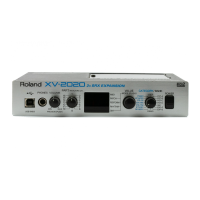68
Creating a Rhythm Set
RHYTHM CONTROL (Other Settings)
VEL SENS
(TVA level velocity sensitivity)
-63–+63 Use this setting when you want keyboard touch (velocity) to affect the Rhythm Tone
volume. Set this to a positive value to have the changes in tone volume increase the
more forcefully the keys are played; to make the Rhythm Tone play more softly as you
play harder, set this to a negative value.
PAN
(Rhythm tone pan)
L64–63R This specifies the stereo position of the Rhythm Tone. L64 places the Rhythm Tone
hard left, 0 puts it dead-center and 63R pans it hard right.
RANDOM PAN DEPTH 0–63 Use this parameter to activate random panning, note-by-note. Higher values result in
more extreme fluctuations in the Rhythm Tone’s stereo placement.
ALT. PAN DEPTH
(Alternate pan depth)
L63–63R This setting causes panning to be alternated between left and right each time a key is
pressed. Higher values result in a greater left/right width. You can select the stereo
placement of the first key using this parameter—its opposite will be used for the sec-
ond note, and so on back and forth. If you want to alternate the pan position of two
Rhythm Tones, set them to the exact opposite L and R settings.
TVA ENVELOPE
This specifies the manner in which keyboard ve-
locity will affect the times of the TVA envelope.
ENV T1 SENS
(TVA envelope time 1 velocity
sensitivity)
-63–+63 Use this parameter when you want keyboard playing dynamics (velocity) to affect T1
(Time 1) of the TVA envelope. With higher settings, the T1 value will change more sig-
nificantly depending on whether you play softly or with greater force. With positive
(+) settings, greater keyboard velocity will reduce the T1 setting. With negative (-) set-
tings, greater keyboard velocity will increase the T1 setting.
ENV T4 SENS
(TVA envelope time 4 velocity
sensitivity)
-63–+63 Use this parameter when you want key-off velocity—the speed at which you release a
key—to affect T4 (Time 4) of the TVA envelope. With higher settings, the T4 value will
change more significantly depending on whether you release the key slowly or quick-
ly. With positive (+) settings, faster key-off velocity will reduce the T4 setting. With
negative (-) settings, faster key-off velocity will increase the T4 setting.
ENV T1–T4
(TVA envelope time 1–4)
0–127 Specify the TVA envelope times. Higher settings lengthen the time until the next vol-
ume level is reached. (For example, T2 is the time over which L1 changes to L2.)
ENV L1–L3
(TVA envelope level1–3)
0–127 Specify the TVA envelope levels. These settings specify how the volume changes at
each point, relative to the standard volume.
SEND LEVEL DRY
(Dry Send Level)
Refer to p. 78.
SEND LEVEL CHO
(Tone Chorus Send Level)
SEND LEVEL REV
(Tone Reverb Send Level)
OUTPUT ASSIGN
(Tone Output Assign)
Parameter Value Description
PITCH BEND RANGE
(Rhythm tone pitch bend range)
0–48 Specifies the amount of pitch change that will occur when you move the Pitch
Bend Lever.
MUTE GROUP OFF, 1–31 The Mute Group function allows you to designate two or more Rhythm Tones
that are not allowed to sound simultaneously. For example, in a real-world
acoustic drum set, an open hi-hat and a closed hi-hat sound will never occur
simultaneously, since they’re produced by the same instrument. To simulate
this behavior on the XV-2020, you can set the open and closed hi-hat Rhythm
Tones to the same Mute Group. You can have up to 31 Mute Groups per
Rhythm Set. If you do not want a Rhythm Tone to use a Mute Group, turn the
feature off.
ASSIGN TYPE
(Assign type)
MULTI, SINGLE This setting determines whether a Rhythm Tone note that is playing is
stopped when the same note is played again (SINGLE), or whether it will con-
tinue to play, layered with the new note.
Parameter Value Description
T1 T2 T3 T4
L3
L1
L2
Level
key is pressed key is released
Time

